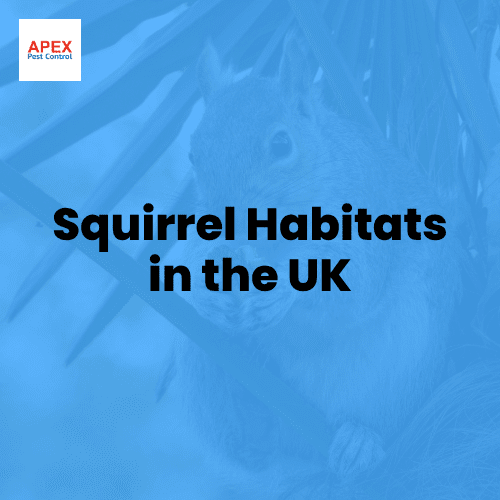Inside the World of Squirrels: Understanding Their Habitats Across the UK
Squirrels are among the UK’s most recognisable and charismatic wild animals. Behind their playful appearance lies a complex story of survival, competition, and conservation.
The native red squirrel (Sciurus vulgaris), once widespread across the country, now clings to fragmented strongholds. Meanwhile, the invasive grey squirrel (Sciurus carolinensis), introduced from North America in the 19th century, has come to dominate much of the landscape.
This article explores the intricacies of squirrel habitats, the challenges facing red squirrels, the science and strategy behind conservation efforts, and how everyone can play a part in securing a future for these iconic creatures.
Discover how to protect your property with our comprehensive guide to Squirrel Exclusion Devices, covering effective installation methods, key benefits, and legal considerations.
The Native Red Squirrel: A Species Under Threat
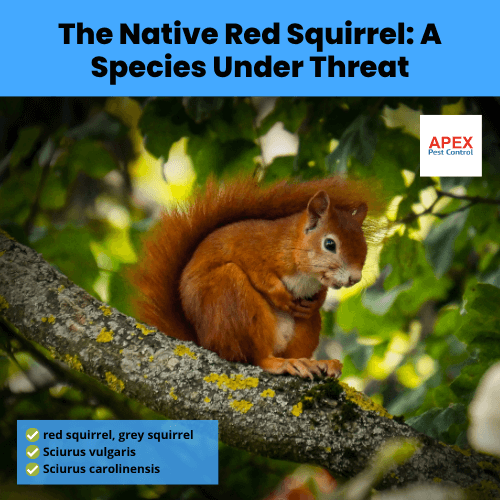
The red squirrel is a native species to the UK, and it thrives in coniferous forests on a diet of seeds, nuts, berries, and fungi. Historically, red squirrels were common throughout the UK, but their numbers have plummeted by over 90% since the 1950s. Habitat loss, disease, and competition from grey squirrels have been the primary drivers of this decline.
One of the biggest threats to red squirrels is the squirrelpox virus, carried by grey squirrels. This virus is harmless to greys but often fatal to reds, causing severe outbreaks that decimate local populations.
Here’s a quick comparison of red and grey squirrels:
| Feature | Red Squirrel | Grey Squirrel |
|---|---|---|
| Scientific Name | Sciurus vulgaris | Sciurus carolinensis |
| Native Status | Native to UK | Invasive (introduced 1876) |
| Habitat | Coniferous woodlands | Broadleaf forests, urban parks |
| Diet | Seeds, nuts, berries, fungi | Acorns, seeds, nuts, buds |
| Squirrelpox Impact | Fatal | Carrier (not affected) |
Grey Squirrels: An Invasive Competitor
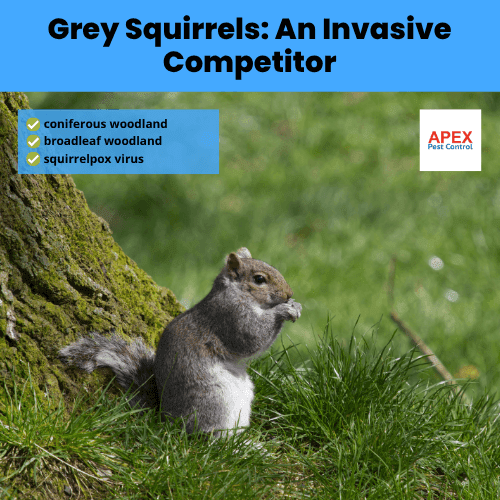
Introduced to the UK in the late 19th century, grey squirrels quickly adapted to their new environment. They can digest acorns more efficiently than reds, giving them a crucial advantage in many woodlands.
Additionally, their aggressive behaviour and larger size often displace red squirrels from food sources and nesting sites.
Grey squirrels are now widespread across England and Wales and are increasingly present in parts of Scotland and Northern Ireland. Their presence, coupled with disease transmission, poses a significant threat to red squirrels in the UK.
Conservation Strategies: Buffer Zones and Humane Control
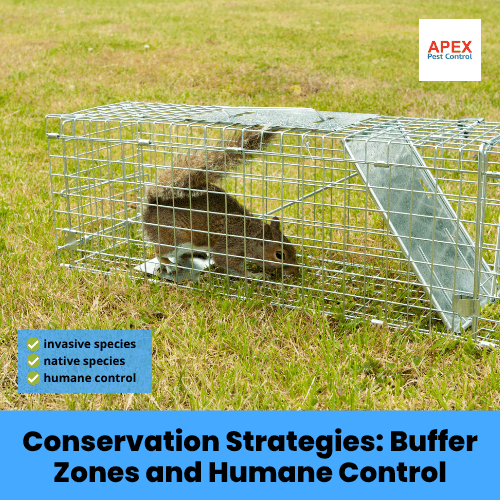
One of the most effective conservation strategies is the creation and careful management of buffer zones. These areas help protect red squirrel populations from the encroaching threat of grey squirrels and the spread of squirrelpox.
In regions like the Sefton Coast Red Squirrel Stronghold, conservationists have implemented humane, legally compliant measures to reduce grey squirrel density. This work is critical for allowing red squirrels to persist and recover in fragmented woodlands.
According to UK pest control regulations and British Pest Control Association (BPCA) guidelines, trapping operations in these buffer zones must follow strict welfare standards:
Traps must be checked at least every 12 hours to minimise stress and ensure humane treatment.
Non-target species caught must be released unharmed.
It is illegal under the Wildlife and Countryside Act 1981 to release grey squirrels back into the wild. Once captured, they must be dispatched humanely by a competent person.
These efforts focus not on eradicating grey squirrels completely but on creating safe habitats where red squirrels can survive and thrive.
Case Study: Sefton Coast Red Squirrel Stronghold
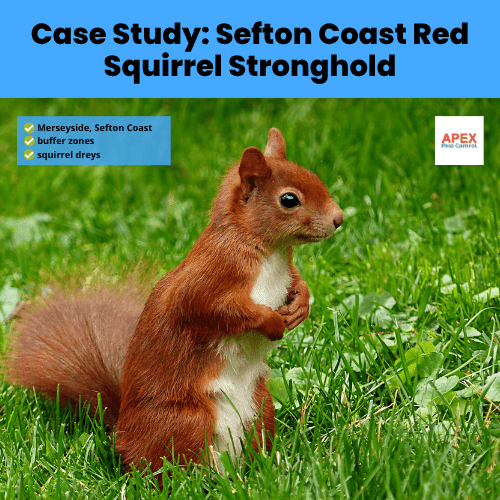
The Sefton Coast, stretching along Merseyside’s coastline, is a leading example of how strategic, humane control efforts can support red squirrel populations. Here, over 2,500 hectares of red squirrel habitat are actively managed.
The combination of grey squirrel control and habitat restoration has allowed red squirrels to persist and even recover in parts of the Sefton Coast. Conservation work in the area is led by organisations like the Lancashire Wildlife Trust and involves constant monitoring and data-driven decision-making.
Advanced tools like GPS-based tracking systems help conservationists identify grey squirrel movement patterns and prioritise prevention corridors. This ensures that resources are targeted where they will have the greatest impact, improving both animal welfare and conservation outcomes.
“Our goal isn’t to blame the grey squirrel, but to give the red squirrel a fighting chance where it still has hope.” – UK Squirrel Accord
Squirrel Habitat Management: Creating a Supportive Environment
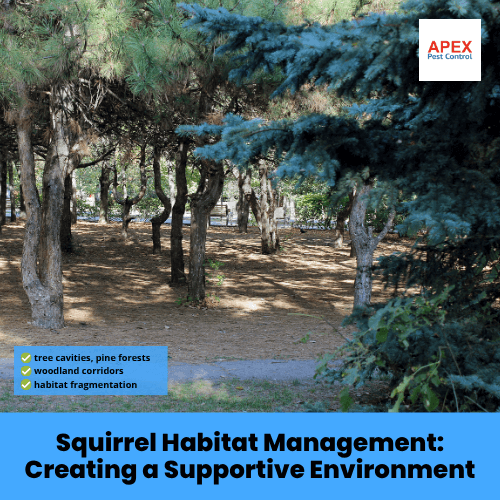
Habitat management is equally vital in the effort to protect red squirrels. Beyond controlling grey squirrel numbers, creating and maintaining suitable habitats for red squirrels helps ensure their long-term survival.
Key habitat management strategies include:
- Planting coniferous trees: Red squirrels favour coniferous woodlands, which provide them with consistent food sources and safe nesting sites.
- Maintaining woodland diversity: Mixed woodland with a range of tree species supports a more resilient ecosystem and year-round food availability.
- Creating wildlife corridors: Linking fragmented habitats allows red squirrels to move safely between areas, boosting genetic diversity and strengthening populations.
These improvements benefit not only red squirrels but also a wide range of woodland wildlife.
Key UK Legislation and Professional Standards
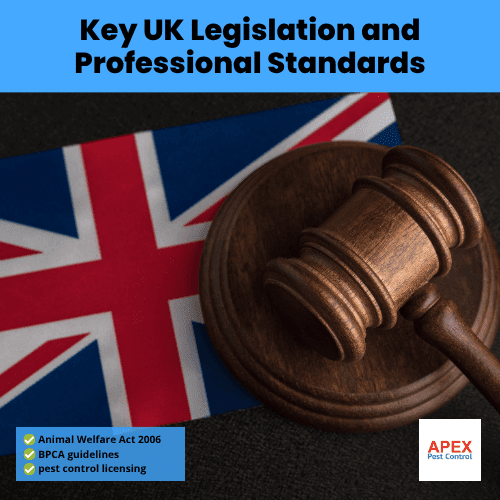
All squirrel control and conservation activities in the UK must comply with current legislation and standards, including:
- Wildlife and Countryside Act 1981: Protects native species and regulates control of invasive species.
- Animal Welfare Act 2006: Ensures humane treatment of animals in trapping and control.
- Spring Traps Approval Order 1995: Mandates the use of legally approved traps.
- Licensing and Technician Qualifications: Pest control professionals must be fully trained and qualified, following BPCA and RSPH standards.
Traps used in squirrel control must be inspected at least every 12 hours to meet welfare standards. These measures help ensure that control activities are both humane and legally compliant.
For full details, consult resources such as GOV.UK: Wild mammals management and control options and BPCA squirrel control guidelines.
Community Involvement: How You Can Help
Public involvement is essential to the success of red squirrel conservation. Here’s how you can help:
Report sightings: Noting where red and grey squirrels are seen helps conservation groups monitor populations and plan interventions.
Support local initiatives: Donating to or volunteering with conservation projects provides crucial funding and manpower.
Avoid feeding squirrels in overlapping areas: Feeding can increase disease transmission and inadvertently support grey squirrels in red squirrel strongholds.
Raise awareness: Sharing information about red squirrel conservation helps build broader community support and engagement.
By taking these steps, individuals can play a part in preserving the UK’s native wildlife.
The Future of Red Squirrel Conservation
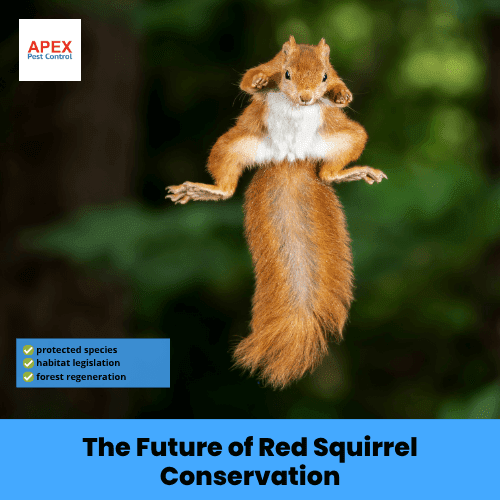
Conservation of red squirrels in the UK is a multifaceted challenge requiring continued collaboration between government agencies, conservation organisations, landowners, and the public. While significant progress has been made in stronghold areas like the Sefton Coast, grey squirrels remain a persistent threat in many regions.
Future conservation strategies may include innovative solutions like fertility control for grey squirrels and expanded habitat restoration efforts. These tools, combined with ongoing research, humane control practices, and community involvement, offer hope for a future in which red squirrels once again flourish across the UK’s woodlands.
Take Action
If you’re dealing with squirrels in your area or want to support red squirrel conservation, always work with trained, qualified professionals who adhere to UK regulations. Speak to a licensed pest control technician or wildlife conservation officer for tailored advice and to ensure that interventions are safe, legal, and humane.
Together, we can ensure that red squirrels not only survive but thrive for generations to come.
Conclusion
Red squirrels are a treasured part of our woodland heritage, but their future depends on the choices we make today. By protecting habitats, supporting conservation, and making wildlife-friendly changes in our gardens and communities, we can all help secure a brighter future for red squirrels across the UK.
If you are experiencing problems with grey squirrels in your home, garden, or business—especially in South Yorkshire—professional help is available.
Apex Pest Control offers expert, humane pest control services tailored to squirrel issues, helping to protect both your property and local wildlife. Their team understands the importance of responsible grey squirrel management as part of wider conservation efforts.
Take action today:
Support red squirrel conservation by making your outdoor spaces wildlife-friendly.
Get involved with local projects and citizen science.For safe and effective squirrel pest control in South Yorkshire, contact Apex Pest Control for advice and assistance.
Together, we can ensure red squirrels thrive—not just survive.
Frequently Asked Squirrel Questions
What types of squirrels are found in the UK?
There are two main species of squirrels in the UK: the native red squirrel (Sciurus vulgaris) and the introduced grey squirrel (Sciurus carolinensis). Red squirrels are protected under the Wildlife and Countryside Act 1981, while grey squirrels are considered an invasive species.
Where do squirrels typically build their nests in the UK?
Squirrels in the UK commonly build nests, called dreys, in tree cavities or construct them using twigs and leaves high up in tree branches. They may also nest in attics or outbuildings. It’s important to note that interfering with a red squirrel’s nest is illegal without proper licensing.
What is the legal status of grey squirrels in the UK?
Grey squirrels are classified as an invasive non-native species in the UK. Under the Wildlife and Countryside Act 1981, it is illegal to release grey squirrels into the wild or allow them to escape. Control measures for grey squirrels must be carried out humanely and in accordance with animal welfare laws.
Can I remove squirrels from my property in the UK?
You can legally remove grey squirrels from your property using humane methods. However, red squirrels are protected, and their removal requires a licence from Natural England, Scottish Natural Heritage, or Natural Resources Wales, depending on your location.
What do squirrels eat in UK habitats?
Squirrels in the UK primarily feed on nuts, seeds, buds, fungi, and occasionally insects. They may also eat bird eggs and young birds. Feeding wildlife, including squirrels, is not illegal but should be done responsibly to avoid creating dependencies or nuisances.
How do UK squirrel habitats differ between urban and rural areas?
Urban squirrels often adapt to using man-made structures and gardens, while rural squirrels typically inhabit woodlands. Both environments must provide food, water, and shelter. In urban areas, it’s important to ensure that squirrel control measures don’t inadvertently harm other wildlife.
What impact do squirrels have on UK ecosystems?
Red squirrels play a vital role in seed dispersal and forest regeneration. Grey squirrels, however, can cause damage to trees by stripping bark and may compete with native species for resources. Any ecosystem management must comply with environmental protection laws.
Are there any specific regulations for managing squirrel habitats in protected areas?
In protected areas such as Sites of Special Scientific Interest (SSSIs) or National Nature Reserves, specific permissions may be required for any habitat management or squirrel control activities. Always consult with the relevant authorities, such as Natural England, before undertaking any actions in these areas.
How can I make my garden less attractive to problem squirrels while staying within the law?
Legal methods to deter squirrels include using squirrel-proof bird feeders, removing potential food sources, and sealing entry points to buildings. Physical barriers and non-toxic repellents are also permissible. However, any deterrents used must not cause unnecessary suffering to squirrels or other wildlife, as this would violate animal welfare laws.

Tony Johnson, Founder & Lead Technician at Apex Pest Control, is a BPCA and NPTA accredited pest management expert with over 35 years’ hands-on experience. Tony specialises in Integrated Pest Management and ensures all services comply with UK pest legislation, including the Wildlife and Countryside Act 1981 and COSHH Regulations 2002. His commitment to continual learning and adapting to industry best practices means clients receive effective, safe solutions for pests affecting homes and businesses across South Yorkshire. Tony’s dedication to professional standards, ethical treatment methods, and local expertise has made him a trusted partner for pest control and prevention.
-
BPCA & NPTA accredited | CHAS certified
-
Committed to UK pest law compliance & safety
-
Focused on effective, ethical pest management for South Yorkshire

